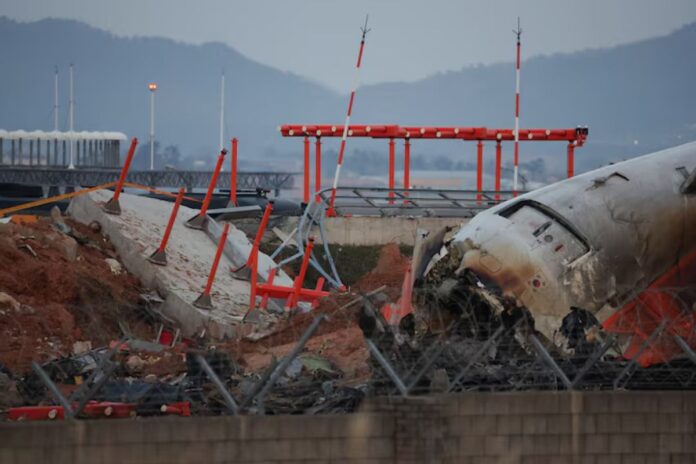Jeju air plane crash investigators are delving deeper into the circumstances surrounding the deadly accident at Muan International Airport, which claimed 179 lives in the worst aviation disaster in South Korea’s history. The crash of Jeju Air Flight 7C2216, a Boeing 737-800 traveling from Bangkok to Muan, has raised pressing questions about operational safety and infrastructure standards.
The aircraft belly-landed on the runway and overshot its length, colliding with an embankment that caused it to explode into flames. While two crew members survived, one remains in critical condition, and the other is recovering from injuries.
Investigators Raid Jeju Air and Airport Operator
South Korean police executed searches at Jeju Air’s Seoul office, Muan International Airport’s operator, and the transportation ministry’s aviation authority. The raids aimed to gather evidence related to aircraft operation, maintenance, and airport facility management.
Authorities have restricted Jeju Air’s CEO, Kim E-bae, and another high-ranking official from leaving the country. They are key witnesses potentially facing charges of causing deaths by negligence. If convicted, they could face up to five years in prison or a fine of up to 20 million won ($13,600).
Jeju Air’s Director Song Kyeong-hoon confirmed the airline’s cooperation with the investigation, stating, “We will assist fully to uncover the cause of this tragedy.”
Focus on the Rigid Embankment Design
A major point of contention is the embankment near the runway’s end, which housed a localizer antenna—a critical component for guiding landings. Engineering experts have criticized the design, calling it unnecessarily rigid and dangerously close to the runway.
“This rigid structure proved catastrophic when the skidding aircraft made impact,” said Najmedin Meshkati, a University of Southern California engineering professor. He highlighted the need for safer designs, such as standard metal towers, instead of concrete installations.
The transport ministry has acknowledged these concerns and is reviewing navigation systems at airports nationwide. Deputy Transport Minister Joo Jong-wan stated, “We are prioritizing safety checks and re-evaluating current infrastructure designs.”
Cockpit Voice and Flight Data Recorders Under Analysis
The cockpit voice recorder’s audio files have been successfully converted, potentially shedding light on the final moments before the crash. However, due to their significance to the ongoing investigation, these files may not be released publicly.
The flight data recorder, damaged during the incident, has been sent to the U.S. for analysis in collaboration with the National Transportation Safety Board (NTSB) and Boeing.
Unanswered Questions About Jeju Air Plane Crash
Key questions remain unanswered, including why the landing gear was not deployed and why the pilot attempted a second landing after reporting a bird strike and declaring an emergency. Investigators from the NTSB, Federal Aviation Administration (FAA), and Boeing are assisting South Korean authorities to determine the causes.
Government Calls for Comprehensive Safety Measures
Acting President Choi Sang-mok emphasized the need for stringent inspections of all Boeing 737-800 aircraft operating in the country. “Public safety is paramount,” Choi said during a disaster management meeting. He also urged the transport ministry to enhance training and maintenance protocols to prevent similar tragedies.
Choi further instructed authorities to provide comprehensive support to the victims’ families and to curb the spread of misinformation about the disaster.
This investigation serves as a grim reminder of the need for stringent aviation safety standards, particularly concerning infrastructure design and operational protocols.

